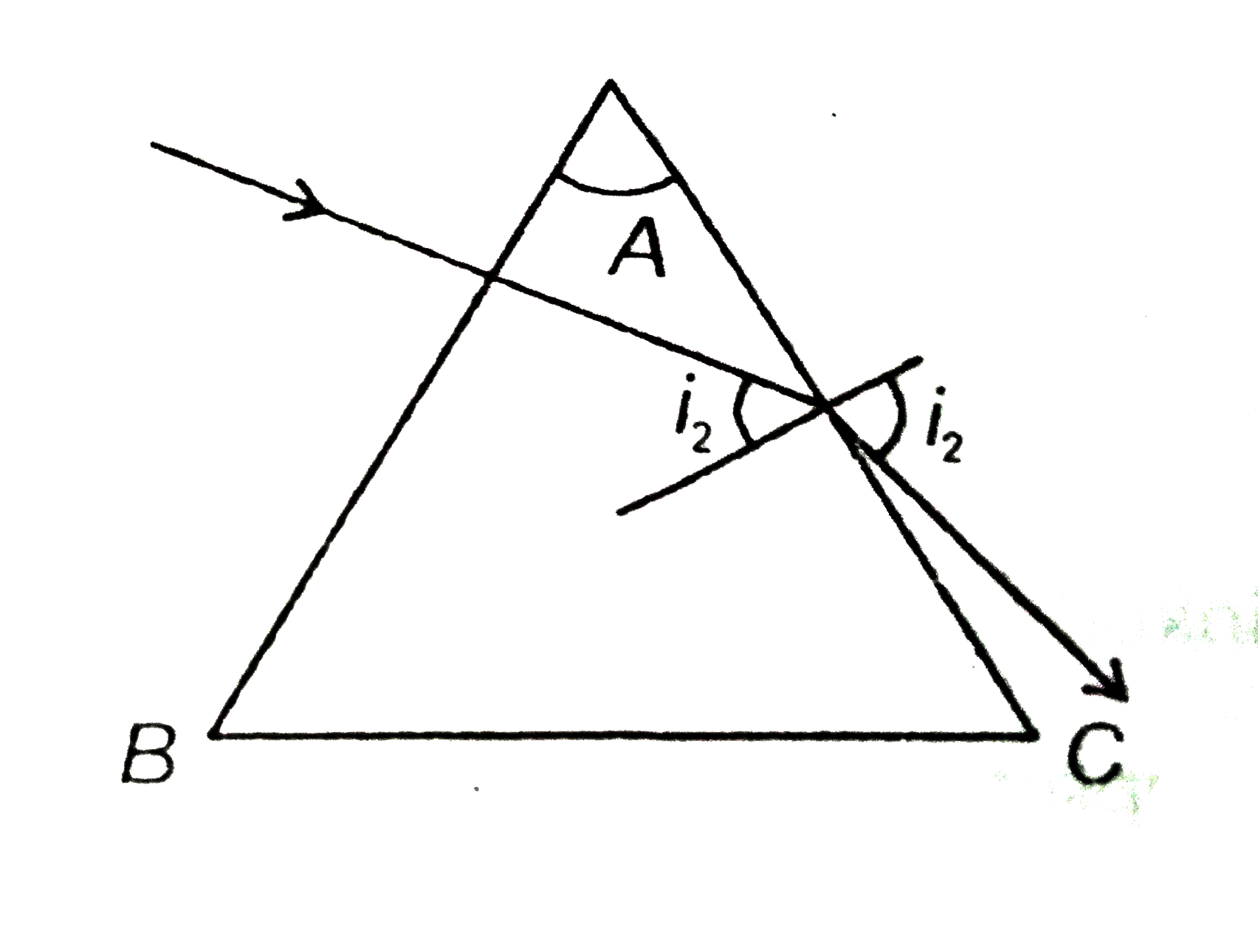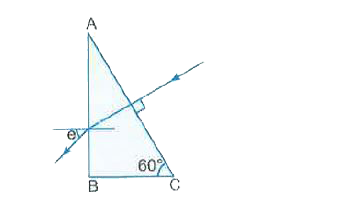Light falls at normal incidence on one face of a glass prism of refractive index 1.5, what will be the angle of emergence when the angle of the prism is (a) 30∘ (b) 50∘ ?
The incident ray is normal to the face AB of the prism shown in the figure. So, the angle of incidence, i1=0 making r1=0
When light undergoes refraction through a prism, r1+r2=A
(a) 0+r2=30∘
r2=30∘
sini2=μsinr2=1.5sin30∘=1.5(0.5)=0.75
(b) A=50∘
Substituting in r1+r2=A
0+r2=50∘,r2=50∘
sini2=μsinr2=1.5sin50∘=1.5(0.7660)=1.149
No value of i2 can satisfy this relation. So, there is not refraction at the second surface i.e., there is no emergent ray from the face AC of the prism. The light is totally reflected as r2 is greater than the critical angle.

Topper's Solved these Questions
- RAY OPTICS AND OPTICAL INSTRUMENTSBook:AAKASH INSTITUTEChapter:RAY OPTICS AND OPTICAL INSTRUMENTSExercise:Assignment (Section - A) Objective Type Questions (One option is correct)
Explore 38 Videos
- RAY OPTICS AND OPTICAL INSTRUMENTSBook:AAKASH INSTITUTEChapter:RAY OPTICS AND OPTICAL INSTRUMENTSExercise:Assignment (Section - B) Objective Type Questions (One option is correct)
Explore 16 Videos
- PHYSICAL WORLDBook:AAKASH INSTITUTEChapter:PHYSICAL WORLDExercise:ASSIGNMENT (Section-B)
Explore 5 Videos
- SEMICONDUCTOR ELECTRONICS (MATERIAL, DEVICES AND SIMPLE CIRUITS )Book:AAKASH INSTITUTEChapter:SEMICONDUCTOR ELECTRONICS (MATERIAL, DEVICES AND SIMPLE CIRUITS )Exercise:Assignment SECTION - D (Assertion & reason type Question)
Explore 10 Videos
Similar Questions
A ray of light incident normally on the first face of a glass prism of refractive index 1.6 just emerges from the other face. Find the angle of the prism.
View SolutionCalculate the angle of emergence (e) of the ray of light incident normally on the face AC of a glass prism ABC of refractive index √3. How will the angle of emergence change qualitatively, if the ray of light emerges from the prism into a liquid of refractive index 1.3 instead of air ?

View Solution
Knowledge Check
Light falls at normal incidence on one face of a glass prism of refractive index √2. Then the angle of emergence when the angle of the prism is 45∘
A45°B60°C15°D90°A ray of light is incident normally on one of the equal faces of a right isosceles prism of refractive index 1.5. The angle between incident and emergent rays is
A45∘B90∘C180∘D0∘The least angle of deviation for a glass prism is equal to its refracting angle. The refractive index of glass is 1.5. Then the angle of the prism is
A2cos−1(34)Bsin−1(34)Csin−1(32)Dcos−1(32)
A ray of light is incident on the glass prism at an angle of 40∘. Find the angle of emergence, if the angle of prism is 60∘ and refractive index is 1.5.
View SolutionWhen a ray of light is incident normally on one refracting surface of an equilateral prism of refractive index 1.5, then
View SolutionA ray of light is incident normally on one face of an equilateral prism of refractive index 1.5. The angle of deviation is: (Given sin−1.23=42∘)
View SolutionThe angle of prism is 60∘ and its refractive index is 1.5. There will be no emergent light if the angle of incidence on the first face is
View SolutionA ray of light is incident normally normallyh on one of the faces of a prism of apex angle 30∘ and refractive index √2. The angle of deviation of the ray is ________________ degrees.
View Solution